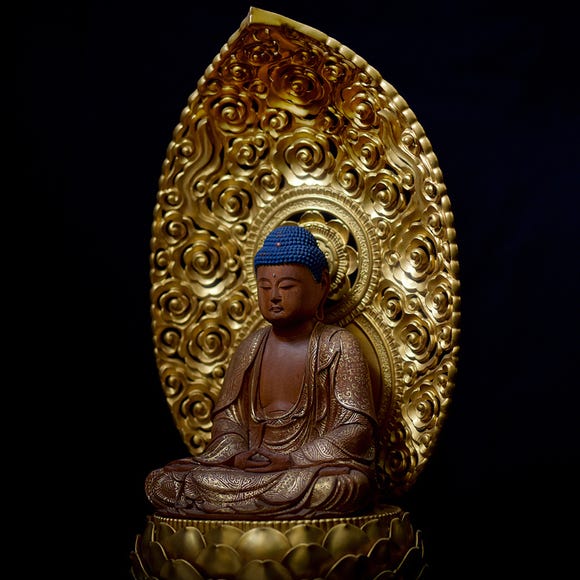
While exploring cities in Japan, you’ll often spot small shops with charming raccoon-like statues out front. These represent the Japanese tanuki, a native animal featured in many myths and stories, and sometimes called a raccoon-dog due to mistranslations. Let’s take a closer look!
Tricks and Magic: Old Legends of the Japanese Tanuki

The tanuki has a rather malevolent past. The oldest tales and legends speak not only of its possession of humans but also of its shape-shifting abilities.
One of the most famous myths about the tanuki is its power to transform into a beautiful woman, using this guise to play mischievous tricks on passersby. In addition to changing its own form, the tanuki can also transform objects, such as turning pebbles into gold or feces into food.
A common depiction of this magical and malevolent creature features a leaf on its forehead, which is believed to be the source of its power.
The Seat of a Tanuki’s Power: the Scrotum

While leaves might be considered a source of the creature’s power, the true magic actually comes from a different body part: the scrotum. Remarkably stretchable and enlargable, this unusual magical scrotum can be used for various purposes.
Drawings and tales depict the tanuki using its scrotum to craft a boat to rescue people from a river or as a parachute or blanket. This is why many tanuki statues feature an exaggerated scrotum, as it is believed to bring good luck in business.
From Menace to Merry Drinker

Over time, the malevolent tanuki evolved into a much tamer version. Although they still use their illusionary magic, they are now seen more as mild annoyances rather than actual threats, known for playing harmless tricks on travelers, hunters, or monks.
If you wander through the Japanese woods and hear music, it might be a tanuki playing its magical belly-drum. Be cautious and don’t follow the sound, or you might end up getting lost!
This shift in perception has led to the cheerful and happy depictions of tanuki in today’s sake-holding statues, which can be found in many shops across the country.
The Tanuki’s Lucky Straw Hat

Another notable feature of these statues is the straw hat that nearly every tanuki wears. This hat, which first appeared around the 18th century, references an older song about a tanuki that steals sake from a brewery on rainy nights.
Today, the straw hat symbolizes preparedness for both bad weather and bad luck. It gradually replaced the magical leaf on the tanuki’s head over time.
Real-Life Animals

While encountering a magical tanuki is quite rare, spotting a real-life tanuki is not uncommon. Similar to raccoons, they have begun to migrate to suburban and even urban areas, foraging for food in dumpsters or being fed by local residents.
You might come across one of these little shapeshifters while strolling through a city or village at night or in the early morning hours. Just be cautious not to be tricked by them!
*Prices and options mentioned are subject to change.
*Unless stated otherwise, all prices include tax.
Popular Tours & Activitiess
Recommended places for you
-
Goods

Yoshida Gennojo-Roho Kyoto Buddhist Altars
Gift Shops
Nijo Castle, Kyoto Imperial Palace
-

Jukuseiniku-to Namamottsuarera Nikubaru Italian Nikutaria Sannomiya
Izakaya
Kobe, Sannomiya, Kitano
-

Kambei Sannomiyahonten
Yakiniku
Kobe, Sannomiya, Kitano
-
Appealing

Rukku and Uohei
Izakaya
Sapporo / Chitose
-

ISHIDAYA Hanare
Yakiniku
Kobe, Sannomiya, Kitano
-

Kanzenkoshitsuyakinikutabehodai Gyugyu Paradise Sannomiya
Yakiniku
Kobe, Sannomiya, Kitano
-

Keisei × Keikyu 16-Temple Goshuin Tour: Discover Deeper Tokyo & Yokohama
by: Guest Contributor
-

Tokyo City Pass Upgrade: Harry Potter Studio Tour & Top Sights up to 85% Off
by: Guest Contributor
-

The Best Japanese Food Representing 2025! 'Dish of the Year®' Annual Award Results Announced
-

Strawberries, Style, and Tokyo’s Coolest Neighborhood: Winter Afternoon Tea in Kichijoji
by: Guest Contributor
-

[Extended Offer!](12% OFF KKday Coupon) Mt. Fuji Autumn Leaves, Powder Snow & More! 15 Best Tours to Experience Japan in Fall & Winter
-

Simply Oishii Wagashi School Discover Japanese Culture Through Wagashi: A Hands-On Experience!
by: Guest Contributor
-

Kiyomizu-dera Temple: Guide to Visiting Kyoto's Most Famous Sightseeing Spot
-

Racing Across Japan in the Joetsu Shinkansen: From Tokyo to Niigata's Sake Country In Style
-
Ad

Brand-Name Luxury at Bargain Prices?! Why Japan is the Best Place to Buy Quality Watches!
-

Hirosaki Castle (Aomori): Home to Some of Japan's Dreamiest Cherry Blossoms
-

LeTAO: Why Are Japan's Northern Sweets so Good?! (Warning: Don't Look If You're Hungry!)
-

Sapporo New Chitose Airport (CTS): Complete Guide to Restaurants, Souvenirs, Shopping & More!
- #best sushi japan
- #what to do in odaiba
- #what to bring to japan
- #new years in tokyo
- #best ramen japan
- #what to buy in ameyoko
- #japanese nail trends
- #things to do japan
- #onsen tattoo friendly tokyo
- #daiso
- #best coffee japan
- #best japanese soft drinks
- #best yakiniku japan
- #japanese fashion culture
- #japanese convenience store snacks
















